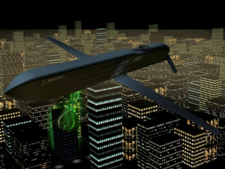Boeing Successfully Tests Missile That Takes Out Electronic Targets
Daily News Article — Posted on November 30, 2012

Boeing and the U.S. Air Force Research Laboratory Directed Energy Directorate, Kirtland Air Force Base, N.M., successfully tested the Counter-electronics High-powered Microwave Advanced Missile Project (CHAMP) during a flight over the Utah Test and Training Range that was monitored from Hill Air Force Base. (credit: Boeing)
(from CBS St. Louis) HILL AIR FORCE BASE, Utah – Boeing has successfully tested a new missile that can take out electronic targets with little collateral damage.
The aerospace company tested the microwave missile [in October] on a two-story building on the Utah Test and Training Range where computers and electronic systems were turned on to gauge the effects of the missile’s radio waves, according to a Boeing press release.
The missile, known as CHAMP (Counter-electronics High-powered Advanced Missile Project), fired a burst of High Powered Microwaves at the building, successfully knocking out the electronic systems and computers, and even taking out the television cameras recording the test.
“This technology marks a new era in modern-day warfare,” Keith Coleman, CHAMP program manager for Boeing Phantom Works, said in the press release. “In the near future, this technology may be used to render an enemy’s electronic and data systems useless even before the first troops or aircraft arrive.”
Seven targets were taken out in total during the one-hour test which left no collateral damage.
Coleman believes this can be a huge advancement forward in non-lethal warfare.
“Today we turned science fiction into science fact,” Coleman said in the press release.
James Dodd, vice president of Advanced Boeing Military Aircraft, is hoping to get these microwave missiles in the field sooner rather than later.
Members of the U.S. Air Force Research Laboratory Directed Energy Directorate and Raytheon Ktech also took part in the test.
Boeing Defense, Space & Security division is headquartered in St. Louis.
CBS News local St. Louis. All Rights Reserved. Reprinted here for educational purposes only. May not be reproduced on other websites without permission from CBS News. Visit the website at stlouis.cbslocal.com. (Note: This article was published at CBS on Oct. 25, 2012)
Background
CHAMP uses electromagnetic pulses:
- The idea of using microwaves or electromagnetic pulses (EMPs) to knock out electronic systems without having to reduce cities or military bases to rubble first arose during Cold War nuclear tests. Nuclear explosions created EMPs that unexpectedly damaged some civilian power grids and facilities.
- That spawned the military dream of a nonlethal takedown weapon that could disable an enemy's radar, communications and targeting computers - effectively leaving them blind and unable to respond effectively to follow-up attacks by regular military forces. Such weapons could prove especially useful when assaulting enemies hidden in heavily populated cities or towns without causing civilian casualties.
- But the secrecy surrounding U.S. military weapons research led some critics to argue that microwave weapons represented an impossible dream as recently as last month.
- Such critics were apparently wrong. The CHAMP missile's microwaves proved so effective during the recent test that they knocked out some of the cameras used to record video footage of rows of computers blinking off. CHAMP went on to hit seven targets during the one-hour test.
- CHAMP's three-year, $38 million program could eventually deploy up to five prototype missiles. The latest testing seems to suggest that Boeing and the Air Force have succeeded in creating a functional missile capable of taking out many targets with multiple shots. (from foxnews.com)
- How long the electronics are disrupted for would vary widely depending on how the electronics work and how hard they were hit. The monitors shown in the video at Boeing's announcement of the tests only shut down for a few seconds, but something more complex, like an interdependent network of computers and power sources, could be taken offline for much longer or even disabled completely. Either way, the CHAMP was demonstrated successfully, and it will be a very useful tool when ordinary munitions are too risky to employ. (from nbcnews.com)
